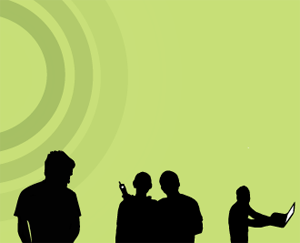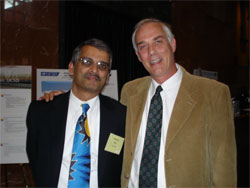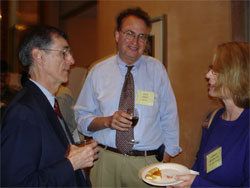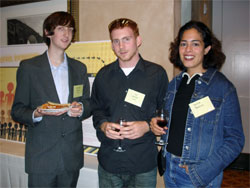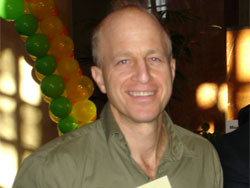UCSD Division's Calit2 hosted a first-ever - "Student Spectrum"
|
10.27.04 - Calit² demonstrated its liveliness and fun-loving character once again at the UCSD division's "Student Spectrum" event Monday night. The event showcased the research accomplishments of a large percentage of the 300 students - both graduate and undergraduate - supported by Calit² industrial partners over the last three years.
Ramesh Rao, UCSD division director and overseer of the industry program, was impressed by the "intensity" of the discussions throughout the poster session. "I think everyone came away with a strong sense of the critical role students play in Calit² and their remarkable record of accomplishment," said Rao. In comments during the program, he mentioned that his office has received more than 50 requests for space in the new UCSD building-accounting for 250% of the available footage. Noted Rao, "I am somewhat astonished and a bit humbled at the level of interest Calit² has drummed up on campus, largely through the activities and enthusiasm of our students."
Rao thanked partners providing student support, especially QUALCOMM, Ericsson, AMCC, Conexant, MindSpeed, SkyWorks, Intersil, IBM, Sun Microsystems, and SAIC. He also thanked the more than 100 professors from 23 departments advising these students, as well as Calit² staff in the UCSD division, particularly student services coordinator Megan Laver who planned the event.
|
|
"The students were very excited to participate," said Laver, who supports the students and facilitates community building among them. "They took great care not only in preparing their posters but explaining them to other attendees. The proof of their enthusiasm was the smiles I saw all around the room."
The event was titled "Student Spectrum," a play on "electromagnetic spectrum" and a reference to Calit²'s research and education emphasis on telecommunications. The theme of the event was "today's student researchers become tomorrow's technology leaders" - in industry, academia, and government.
|
The program featured 50 student posters with their creators available to discuss the content; welcome and introductory thoughts by Larry Smarr, Calit² director, and Rao; and presentations by Andrew Kummel, professor of Chemistry and Biochemistry, Jamie Link, graduate fellow in the same department, and James Rohr, SPAWAR.
"America has spent the last 100 years in hyperspecialization and reductionism," said Smarr, "understanding systems by taking them apart and studying them in the smallest detail. But we're now moving beyond that. In Calit², we're linking students with expertise in a wide variety of areas. That doesn't exist in many other places."
As an advisor to the director of the National Institutes of Health, Smarr pointed to NIH's agreement with the value of this approach: "Because diseases are so complex, NIH has cross-training programs to expose students to multiple disciplines and aspects of disease." He also pointed out that Calit²'s "student spectrum" involves all levels of students, even high school students at the UCSD Preuss School who are involved in a robotics initiative.
Kummel drew the biggest laughs during the program, presenting, true to form, his "bizarre sense of humor," as alluded to by Rao when introducing him. In a more serious vein, Kummel thanked the industrial
partners for supporting the students and pointed out that, while UC students represent the top 12% of their graduating high school classes, the students receiving fellowships through Calit² represent the top 1/10 to 2/10 of that group. "In Calit², industry is supporting the absolutely very best students," he said. Kummel also highlighted a number of student research projects related to materials and devices, an area in which he has provided leadership with respect to the design of the clean room in the new UCSD building.
Link tied her research, in dust-sized chips of silicon that allow scientists to detect biological and chemical agents, to modern-day history. She said that 9/11 and being a member of the "first class of Calit² graduate fellows" shaped her graduate studies. "9/11 represented a new challenge to our nation's scientists that would require unprecedented levels of cooperation," she said.
Three years of working with chemists, physicists, biologists, and engineers provided her with a much broader perspective than she anticipated, emphasizing the importance of policy and the development of national and international technical standards. "I've been part of an organization," she said, "where scientists are stepping out of their narrowly defined roles to share their research with the public. What I value most about my experience with Calit² is the insight I've gained about the rapidly expanding role and social responsibility of the researcher."
Jim Rohr, from SPAWAR, focused on the value his organization places on hiring UCSD students. "For our summer internship program funded by the Office of Naval Research, out of 2500 applications from 150 schools, we selected 27 students, including 11 from UCSD. What we like about them is their confidence and willingness to risk failure."
The program was complemented by a seven-minute video - Calit²'s first in high definition - highlighting 20 students and their experience within and without Calit². "Packing a punch with pixels," according to Rao, it was filmed and produced by the UCSD division's media relations manager Doug Ramsey.
As an ongoing service, particularly for the industrial community, the UCSD division has launched a student Website (http://ucsdstudents.calit2.net/) - designed by Calit² Web master Beth Cerny and debuted at this event. This site includes information on the expertise, research projects, and resumes of all students that have received Calit² support, including undergraduates conducting summer research projects, graduate student researchers, and graduate students receiving fellowships from Calit². Students can be searched for alphabetically or by advisor or project keyword. "Part of the goal here is to help partner companies connect with these students for internships and jobs," said Rao, "so we specifically included contact information."
Complementing the festive atmosphere at the event were a Student Spectrum brochure designed by Calit² Web assistant Tim Jaeger and helium balloons reflecting the green, yellow, and orange of the brochure and event signage.
For more information on the UCSD division's student programs, please contact student services coordinator Megan Laver at megan@ucsd.edu or 858-534-0180.


